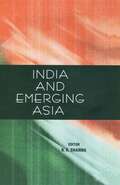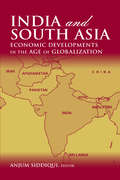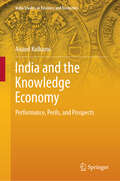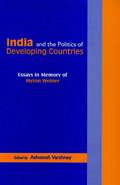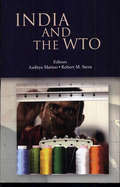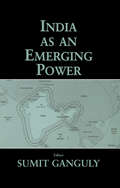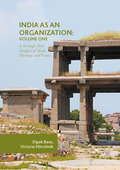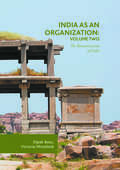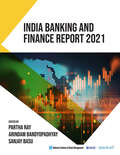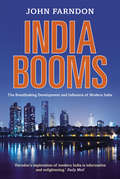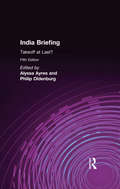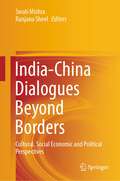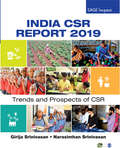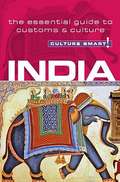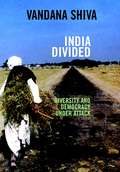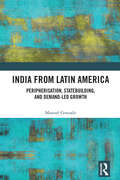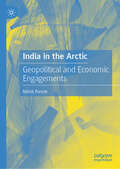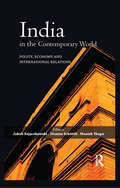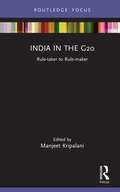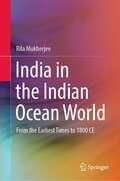- Table View
- List View
India and China in the Emerging Dynamics of East Asia
by G. V. C. Naidu Mumin Chen Raviprasad NarayananThough considerable research literature is now available on China-India relations, most of it still follows a conventional narrative, viewing the relationship through the narrow conflictual prism limited to South Asia than in the new, larger perspective, especially in the context of emerging East Asian dynamics. This book offers comprehensive analyses of some of these issues in papers addressing two broad themes. One, significant trends in the relationship between China and India on a range of issues, including economic development models, their military strategies, and the boundary dispute; and two, how others are responding to the rise of India and China and their impact on East Asia. Together, the chapters constitute a comprehensive study on both China-India relations and their concurrent rise, including a variety of perspectives and methodologies. Written by some of the top experts on the subject from India, China, Japan, and Taiwan and covering a broad range of issues, the book will generate considerable interest in understanding this relatively neglected dimension of today's East Asia.
India and Emerging Asia
by R.R. Sharma and I.K. GujralIn recent years, Asia`s economic and strategic environment has been transformed in a fundamental sense. The emerging `Asian Economic Community`—encompassing ASEAN, China, Japan, India and South Korea—is being widely viewed as the centre of gravity of the global economy. Because of its strategic position, India is destined to play a significant role in shaping the emerging profile of Asia. Against this background, this volume explores Asia`s dramatic re-emergence on the global scene as well as India`s role in ensuring peace, security, stability and development in the continent. In recent years, India has redefined its position within Asia and has emerged as a significant player. The contributors offer new perspectives on Asia concerning the nature of its politics and governance, the reasons for its insecurity, the need for greater regional cooperation, and its intrinsic strengths and weaknesses. They implicitly or explicitly share the view that the `twenty-first century belongs to Asia`.
India and South Asia: Economic Developments in the Age of Globalization
by Anjum SiddiquiSouth Asia has become a major center of attention on the world stage with the U.S. military involvement in Afghanistan since 9/11, the ongoing concern over Islamic fundamentalism in Pakistan, and India's emergence as a regional economic power. In addition, the age-old problems of South Asia - mass poverty, poor infrastructure, misgovernance, rampant corruption, political uncertainty, and regional wars - add to the increased interest in the region. Incorporating the most current information available, the expert international contributors to this handbook examine the economies and geo-political developments of India, Pakistan, Afghanistan, Nepal, Bangladesh, Sri Lanka, and Bhutan. They focus on three core areas of importance: trade and development in the post-WTO era of globalization; macroeconomic adjustment and economic growth; and poverty, governance, the war on terror, and social indicators. With its cutting edge analysis, the handbook is an essential reference for all students, researchers, and practitioners dealing with the region.
India and Southeast Asia in a Changing World: Exploring Relationship Prospects for a Sustainable Future
by Shailza Singh Philip Varghese Shalini Balaiah Sarish SebastianThis book presents a comprehensive analysis of India’s relationship with the Southeast Asian nations in the context of the changing dynamics of international relations and the emergence of Indo-Pacific as the theatre of world politics. It covers a wide range of themes, from strategic to political, economic, diplomatic and security aspects, and assesses how India’s redefining of its role in world politics unfolds through its posture towards the Southeast Asian region.The volume will be of great interest to scholars and researchers of Asian studies, both South Asian and Southeast Asian studies, and politics and international relations. It will also be useful for public policy analysts and think tanks and policymakers.
India and the Islamic Heartlands
by Gagan D. S. Sood"Based on the chance survival of a remarkable cache of documents, India and the Islamic Heartlands recaptures a vanished and forgotten world from the eighteenth century spanning much of today's Middle East and South Asia. Gagan Sood focuses on ordinary people--traders, pilgrims, bankers, clerics, brokers, scribes, among others--who were engaged in activities marked by large distances and long silences. By elucidating their everyday lives in a range of settings, from the family household to the polity at large, Sood pieces together the connective tissue of a world that lay beyond the sovereign purview. Recapturing this obscured and neglected world helps us better understand the region during a pivotal moment in its history, and offers new answers to old questions concerning early modern Eurasia and its transition to colonialism"--
India and the Knowledge Economy: Performance, Perils, and Prospects (India Studies in Business and Economics)
by Anand KulkarniThis book asks fundamental questions about the extent to which India is participating in the global shift towards knowledge-based forms of competitiveness. It charts Indian performance and progress using a unique framework benchmarked against fourteen other countries. In the course of the analysis, critical areas for improvement are identified, and the book provides detailed and objective insights for policy-makers and researchers to facilitate change and institutional reform in India.Readers will derive a comprehensive understanding of India’s performance and prospects as it emerges as a serious global economic player. A particular feature of the work is the development of an original knowledge footprint concept that measures the extent and impact of knowledge development and diffusion domestic and internationally.The views expressed in this book are the author’s.
India and the Patent Wars: Pharmaceuticals in the New Intellectual Property Regime (The Culture and Politics of Health Care Work)
by Murphy HalliburtonIndia and the Patent Wars contributes to an international debate over the costs of medicine and restrictions on access under stringent patent laws showing how activists and drug companies in low-income countries seize agency and exert influence over these processes. Murphy Halliburton contributes to analyses of globalization within the fields of anthropology, sociology, law, and public health by drawing on interviews and ethnographic work with pharmaceutical producers in India and the United States.India has been at the center of emerging controversies around patent rights related to pharmaceutical production and local medical knowledge. Halliburton shows that Big Pharma is not all-powerful, and that local activists and practitioners of ayurveda, India’s largest indigenous medical system, have been able to undermine the aspirations of multinational companies and the WTO. Halliburton traces how key drug prices have gone down, not up, in low-income countries under the new patent regime through partnerships between US- and India-based companies, but warns us to be aware of access to essential medicines in low- and middle-income countries going forward.
India and the Politics of Developing Countries: Essays in Memory of Myron Weiner
by Ashutosh Varshney`The essays in this volume will be welcomed by many political scientists as well as more lay observers of the Indian political situation. It is a welcome addition to our understanding of the evolution of political forces in independent India and deserves serious reading′ - Australian Journal of Political Science The baffling complexity of Indian politics has engaged the attention of many a political scientist. It has also led some to remark on its exceptional nature. Several key insights into the dynamics of Indian politics have been possible because of attempts at theoretical formulations and comparison with other developing countries. These methods served as the foundation for Myron Weiner`s engagement with India. His formidable intellectual acuity was solidly grounded in methodological clarity—a feature that also informs the essays in this volume. This important volume brings together renowned scholars who take Myron Weiner`s original, pioneering and often surprising insights into a wide range of themes—democratization, party politics, pressure groups, federalism, caste, identity politics and ethnic conflict, affirmative action, public policy, and political economy—as their starting point to arrive at conclusions that validate or extend Weiner`s works. Divided into three parts—Party Politics and Democracy, Ethnic Politics, and Political Economy—the essays in the book critique conventional wisdom and some well-known theoretical positions.
India and the WTO: A Stretegy for Development
by Aaditya Mattoo Robert M. SternThis book is designed to clarify India's interests in the World Trade Organization's Doha Development Agenda and to provide a blueprint for its strategy in multilateral negotiations. The focus is on facilitating domestic and external policy reforms that can serve to bolster India's participation in the multilateral trading system and to enhance the effectiveness of India's trade and related policies in achieving developmental goals. Individual chapters address the economic effects on India of the Uruguay Round Negotiations and the prospective Doha Agenda negotiations; the implications of the abolition of the Multi-Fiber Agreement; services issues and liberalization; telecommunications policy reforms; foreign direct investment; intellectual property rights; competition policy; government procurement; standards and technical barriers; trade and environment; and, finally, a comprehensive analysis of the major issues coupled with concrete proposals to guide India's participation in the Doha Development Agenda.
India as an Emerging Power
by Sumit GangulyThese essays examine India's relations with key powers including the Russian Federation, China and the USA and with key adversaries in the global arena in the aftermath of the Cold War. One positive relationship is that of India's relations with Israel since 1992.
India as an Organization: Volume One
by Dipak Basu Victoria MiroshnikThis book is an analysis of the political and philosophical foundations of the development of India's economy, including discussions of what's gone wrong in the past and what can be done to rectify it. The authors provide a detailed analysis of the history and burning issues derived from these historical analysis which are still unresolved today. As well as this, there are analyses of the political economy and both ancient and modern historical perspectives.
India as an Organization: Volume Two
by Dipak Basu Victoria MiroshnikThis book, the second of two volumes, continues the authors' ground-breaking re-examination of India's history and political economy. This volume describes the economic fortunes of India in the second half of the 20th century. Beginning with the reconstruction of the Planning Commission and India's hybrid model of economic planning, the authors describe the multiple shocks weathered by the system before being replaced with a fully free market model after the collapse of the Soviet Union. Chapters consider the stresses placed on India's organisation by the shocks of the twentieth century, from its experiments with a socialist economy to its embrace of the Washington consensus in the 1980s. The impact of the invasion of China in 1962 and India's struggle to find its feet post-partition are also given detailed analysis. The book's unique perspective helps to shed light, for the first time, on how India's organisational structure negotiated the country's immense historical and cultural inheritance with the stresses of a twentieth century nation state.
India Banking and Finance Report 2021
by R. PanneerselvamIndia Banking and Finance Report 2021 presents a lucid yet rigorous discussion on the key facets of the Banking and Financial sector in India. Written primarily by the faculty of National Institute of Bank Management (NIBM), Pune, the report covers a wide spectrum of issues ranging from contemporary macro-financial perspectives against the backdrop of the ongoing pandemic to leadership concerns in Indian banks. The list of subjects included is topical, comprising corporate governance challenges, mergers and acquisitions, problems and prospects of the Bad Bank, latest risk management concepts and frontiers, sectoral studies, digital transformation and leadership paradigms. The report seeks to highlight the emerging challenges and opportunities in the banking and financial sector, glean important lessons from the past, and in some cases speculate on the way forward. It emphasizes on a blend of internal strategies, regulatory reforms and public policy initiatives. The report will stimulate enlightened dialogues on the theoretical, empirical and practical aspects of bank management in India.
India Booms: The Breathtaking Development and Influence of Modern India
by John FarndonThe ancient birthplace of some of the world's major religions and now a modern nuclear power, India is experiencing spectacular economic growth. In twenty-five years its population will overtake that of China, making it one of the most populous and rapidly-developing countries in the world. We all need to know more about this intriguing country.John Farndon explores the changing face of modern-day India and its fundamental contradictions. The country is leading the world in cutting edge technology and research, but it is also home to 40 per cent of the world's malnourished children. It is a liberal democracy, yet its political processes are influenced by some of the most conservative religious ideas in the world. The booming economy is at times both global and archaic. Getting to the heart of these inconsistencies, Farndon gives a fascinating insight into the country as it is now and as it will be in the future, and reveals how the changes in India will affect us all.
India Briefing: Takeoff at Last? (Asia Society Country Briefing Ser.)
by Alyssa Ayres Philip OldenburgSince 2001, India has gained new attention as an emerging world power with a rapidly growing economy, a world-class science and technology sector, and a huge English-speaking labor pool. After a period of escalating tension with neighbor Pakistan, wide-ranging peace talks are underway. Within India, there is an unprecedented mood of optimism about the future. At the same time, the nation wrestles with difficult questions about the place of secularism in society, the role it sees for itself globally and within Asia, and the reality that millions of Indians still live at the subsistence level. This volume of India Briefing examines India's changing fortunes through chapters that cover the economy; the twists and turns of domestic politics; labor in the large informal sector; the cultural roots of Hindu nationalism; the foreign relations rollercoaster; the business of Bollywood; and a special chapter on the range of new resources about India available on the web.
India-China Dialogues Beyond Borders: Cultural, Social Economic and Political Perspectives
by Swati Mishra Ranjana SheelThis book is a collection of contributions related to India–China relationship beyond the issue of borders. It focuses on those elements that play important role in defining, continuing, and strengthening the interaction between the two countries. In doing so, it explores roles of language and linguistics, history and culture, politics and economy, and philosophy and sociology that mediated ancient and modern interfaces. The book observes the role of silk route in the economic, political, and scholarly exchanges between ancient civilizations and in the movement of Buddhism to China and other Asian nations. The contributors highlight how the two countries have co-existed in various eras and tackled issues of conflict and cooperation during lows and highs in the past and present. It pays special attention to the role of language and linguistic competence as an important component of socio-cultural comprehension of a society and introduces major innovations and challenges in teaching and learning the Chinese language. The wide-ranging contributions make the book an attractive resource for academics, think-tanks, diplomats, and researchers working on Asian/India–China studies across the globe.
India CSR Report 2019: Trends and Prospects of CSR (SAGE Impact)
by Girija Srinivasan Narasimhan SrinivasanIndia CSR Report 2019: Trends and Prospects of CSR, commissioned by Gujarat CSR Authority, examines the developments in the adoption of CSR practices in India and documents the changes over the last four years since the inception of the CSR mandate. A data-based assessment of geographical and thematic distribution of CSR projects, the book highlights how corporates have made allocation decisions. First of its kind, this book comprehensively covers different aspects of CSR such as evolution, law, policy, corporate strategies, implementer challenges, and possible solutions to some of the existing challenges. It critically analyses the response of companies, policy aspects, and implementation modalities. Challenges from policy, operations, and community response have been explained and the expectations of implementing agencies taken on board. A review of developments in the CSR space in Gujarat has been carried out and five interesting cases that project institutional and thematic uniqueness have been presented. This is a must-read for all CSR practitioners.
India - Culture Smart!
by Becky StephenIndia is in transition. Since the publication of Culture Smart's first guide to India in 2003, it has been transformed from a developing, third-world country into the world's fastest growing economy. Today, a huge, confident, emerging middle class is exporting technology, brains, and enterprise to the rest of the world. At the same time, young Indians educated abroad are returning home to take advantage of the new opportunities, bringing Western expectations and lifestyles with them. The impact of all this wealth-creation, modernity, and individualism on the timeless values and ancient caste structures of India is beginning to be felt well beyond the great cities, adding yet another facet to the giant kaleidoscope of Indian society. This completely new and up-to-date volume by American author Becky Stephens is unrivalled. It highlights the many subtle and not so subtle changes that are taking place in Indian society, describes and explains those areas of life where traditional attitudes and practices continue to prevail, and offers original insights, practical tips, and vital human information to guide you through the pitfalls and delights of this complex, vibrant, and increasingly important country.
India Divided: Diversity and Democracy Under Attack (Open Media Series)
by Vandana ShivaIn India Divided, environmental, human rights, and antiglobalization activist Vandana Shiva chronicles the internal battles of a nation that is both the world's largest democracy and a leading nuclear power. Shiva describes a society where traditional cultures collide with the new economy of globalization, and charts the course of India's war of fundamentalisms in the age of terror. From the IT centers of Bangalore to the villages of Uttar Pradesh, from the massacre at Gujarat and the popular emergence of Hindutva's narrow communalism to the decades-old battle for Kashmir, India Divided reveals a convergence of globalization and terrorism. Looking to the plights of India's Dalit communities and millions of poor subsistence farmers impoverished or displaced by biotechnology, seed patents, and the spate of mega-dam projects, Shiva argues that these silent killers form a local terror unmatched in devastation. In India Divided Shiva addresses India's most urgent threats with gravity and hope.
India from Latin America: Peripherization, Statebuilding, and Demand-Led Growth
by Manuel GonzaloThis book studies the economic history of India and traces the Indian path of development from a Latin American framework and perspective. Despite sharing many historical and geological similarities, dialogue between the young democracies of Latin America and the Indian subcontinent is still extremely scarce. The volume builds a common research agenda for the economic development of the Global South. It offers Latin American insights and highlights novelties and commonalities the region shares with India’s economic development. It pays special attention to the (geo)political, technological, financial, and institutional aspects related to the specific geographical and demographical features of the Indian subcontinent. A step towards strengthening the dialogue on economic development in the Global South, this book will be of interest to scholars and researchers of heterodox economics, Indian economy, comparative economics, macroeconomics, political economy, economic history, development studies, Latin American studies, and South Asian studies.
India in the Arctic: Geopolitical and Economic Engagements
by Nikhil PareekThis book explores the pitfalls and bottlenecks of viewing the Arctic from a mere scientific prism and offers recommendations to approach it from a strategic construct and climate change by strengthening bilateral and multilateral cooperation with the Arctic states and the Arctic intergovernmental organisations. It discusses the inception and development of the soft law cooperative governance structure prevailing in the Arctic and explores engagement by the various stakeholders including the eight sovereign states, thirteen sovereign states as observers, various intergovernmental and inter-parliamentarian outfits, NGOs, and others desirous of an active participation in the Arctic. It brings out the geo-economic and geostrategic levers which have propelled the Arctic as a key region for emerging great power rivalry. It posits the efforts of Arctic states and the Observers holistically to draw parallels with the Indian efforts requiring greater focus and effort. It critically examines the Arctic Policy released by the government on 17 Mar 2022 that missed the opportunity to elucidate India’s geo-economic, geostrategic, economic, and geopolitical aspirations in the hugely vital region and debates if India’s economic and geopolitical position as well as historical links to the Arctic region fits the requirements of an external observer state and must continue to build on its strengths for mutual betterment.
India in the Contemporary World: Polity, Economy and International Relations
by Manish ThapaThis book brings together Indian and European perspectives on India’s polity, economy and international strategy. It explores internal, regional and global determinants shaping India’s status, position and goals in the early 21st century. Through an array of methodological and theoretical approaches, it presents debates on democracy, economic development, foreign and security policy, and the course of India–European Union relations. The volume will prove invaluable to scholars and students of international relations, politics, economics, history, and development studies, as well as policy makers and economists.
India in the G20: Rule-taker to Rule-maker (The Gateway House Guide to India in the 2020s)
by Manjeet KripalaniThis book analyses the importance of the G20 to India, its role so far, and how it can leverage its presidency year to be an influential author of new global rules. In 2023, India will be the President of the G20 Summit, the world’s most influential multilateral economic forum. For countries like India, the G20 is a unique global institution, where developed and developing countries have equal stature. This creates opportunities to showcase their global political, economic and intellectual leadership, have a significant impact on the global economic governance agenda and make it more inclusive. This volume discusses how the Presidency year gives India the opportunity to ‘… hold the pen, write the rules’ and lead the G20 year intellectually, financially, managerially and administratively. It provides a ringside view of India’s path to the G20 Presidency and examines issues such as the core agenda of the G20; explains the significance of forums like T20, B20, and their proliferations; India’s journey as a marginal player in the G20 to its current status; issue of dedicated leadership and management; and India’s Agenda for 2023. Topical, timely, important and lucidly written, this book in The Gateway House Guide to India in the 2020s series will be key reading for scholars and researchers of economics, multilaterals, global governance, strategic studies, defence studies, SAARC, UN Studies, foreign policy, international relations, international economics and international trade, as well as interest to policymakers, diplomats, career bureaucrats, and professionals working with think tanks, academia and multilateral agencies, and business.
India in the Indian Ocean World: From the Earliest Times to 1800 CE
by Rila MukherjeeThe book integrates the latest scholarly literature on the entire Indian Ocean region, from East Africa to China. Issues such as India's history, India’s changing status in the region, and India's cross-cultural networking over a long period are explored in this book. It is organized in specific themes in thirteen chapters. It incorporates a wealth of research on India’s strategic significance in the Indian Ocean arena throughout history. It enriches the reader's understanding of the emergence of the Indian Ocean basin as a global arena for cross-cultural networking and nation-building. It discusses issues of trade and commerce, the circulation of ideas, peoples and objects, and social and religious themes, focusing on Hinduism, Buddhism, and Islam. The book provides a refreshingly different survey of India’s connected history in the Indian Ocean region starting from the archaeological record and ending with the coming of empire. The author’s unique experience, combined with an engaging writing style, makes the book highly readable. The book contributes to the field of global history and is of great interest to researchers, policymakers, teachers, and students across the fields of political, cultural, and economic history and strategic studies.
India in the World Economy
by Tirthankar RoyCross-cultural exchange has characterised the economic life of India since antiquity. Its long coastline has afforded convenient access to Asia and Africa, and trading partnerships formed in the exchange of commodities ranging from textiles to military technology. In a journey spanning 2,000 years, this book describes the ties of trade, migration and investment between India and the rest of the world, showing how changing patterns of globalisation reverberated on economic policy, politics, and political ideology within India. Through his narrative, Doctor Tirthankar asks three major questions: Is this a particularly Indian story? When did the big turning points happen? Is it possible to distinguish the modern from the pre-modern pattern of exchange? These questions invite a new approach to the study of Indian history by placing the region squarely at the centre of the narrative. This is global history written on India's terms, inviting South Asian, Indian and global historians to rethink both their history and their methodologies.

